-
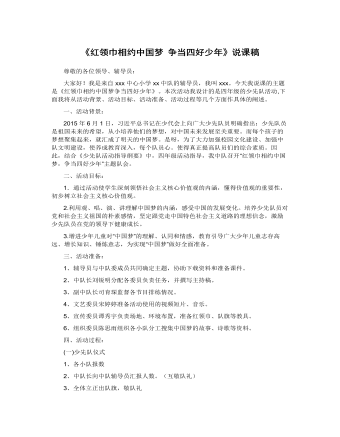
《红领巾相约中国梦 争当四好少年》说课稿
3、展梦想。第三小队通过演讲的形式,展示了自己的中国梦。队员分组通过朗诵诗歌、讲故事和演讲展示自己的中国梦,充分发表自己对社会主义核心价值观的理解,坚定争做四好少年的信心。〖设计意图:社会主义核心价值观比较抽象化,四年级的学生理解起来比较困难,让学生通过表演的形式,在某种程度上视觉感官接受要比抽象图更容易〗第三版块:深入研讨——领悟价值观看各小队表演之后,中队长启发队员们结合自身情况交流学习体会,讨论以下四个问题:(1)观看了视频和同学的表演后,你有什么感想?(2)如何学习树立自己的中国梦?(3)如何用实际行动践行社会主义核心价值观,实现自己的中国梦?让学生结合自身的特点,为自己设定合适的价值观。在此基础上让队员们齐声唱《红领巾心中飘》,道出自己心中的梦想。
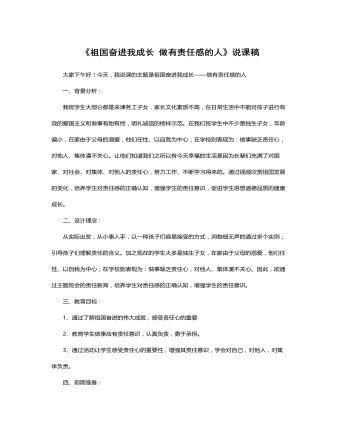
《祖国奋进我成长-做有责任感的人》说课稿
通过观看祖国变化的图片,了解祖国之所以有今天伟大的成就是因为有责任心的中国人凝聚在一起的爱国力量,是每个有责任心的人在自己的岗位上尽心尽力,出色的完成自己的任务。活动一:学生观看表现祖国各行各业奋进的演示文稿。活动二:观看建国六十周年国庆阅兵仪式的片断。活动三:学生代表二人交流:感受到的祖国的变化。活动四:学生交流:自己的感受。(二)理解责任的含义,认识不负责任的危害活动一:知道责任的含义:责任:就是分内应做的事情。也就是承担应当承担的任务,完成应当完成的使命,做好应当做好的工作。认真负责也是爱祖国的表现。责任感就是自觉地把分内的事做好的心情。活动二:通过观看我国航天领域的伟大成就,体验宇航员奋力拼搏,促进航天技术飞速发展的成功喜悦。活动三:通过故事《一个小数点酿成的悲剧》领悟出责任心的重要。了解不负责任的危害。活动四:学生讲出自己身边不负责任的事例。活动五:学生分享自己收获和感受。
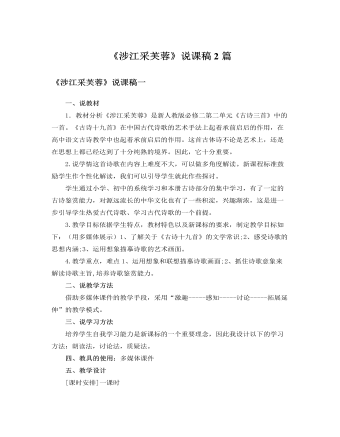
人教版高中语文必修2《涉江采芙蓉》说课稿2篇
一、说教材1.教材分析《涉江采芙蓉》是新人教版必修二第二单元《古诗三首》中的一首。《古诗十九首》在中国古代诗歌的艺术手法上起着承前启后的作用,在高中语文古诗教学中也起着承前启后的作用。这首古体诗不论是艺术上,还是在思想上都已经达到了十分纯熟的境界。因此,它十分重要。2.说学情这首诗歌在内容上难度不大,可以做多角度解读。新课程标准鼓励学生作个性化解读,我们可以引导学生就此作些探讨。学生通过小学、初中的系统学习和本册古诗部分的集中学习,有了一定的古诗鉴赏能力,对源远流长的中华文化也有了一些积淀,兴趣渐浓,这是进一步引导学生热爱古代诗歌、学习古代诗歌的一个前提。3.教学目标依据学生特点,教材特色以及新课标的要求,制定教学目标如下:(用多媒体展示)1、了解关于《古诗十九首》的文学常识;2、感受诗歌的思想内涵;3、运用想象描摹诗歌的艺术画面。

人教版高中语文必修1《鸿门宴》说课稿3篇
3、拓展延伸,启迪心智,创设课堂训练营。三、说学法1、纸上得来终觉浅,圈点、勾画、批注法,学好文言基本功。2、自主合作加探究,眼耳口脑手并用,破疑解难在其中。四、说课时安排《鸿门宴》篇幅较长,文言知识较丰富,文章内涵丰厚,因此我设计用五课时教学本文。第一课时:了解作家作品,积累文言知识,感受作者隐忍发愤的著书精神(初读)第二课时:理清故事情节,概括人物形象,学习客观地评论历史人物,(熟读)第三课时:进一步梳理文言知识,精读课文,要求读透。(精读)第四课时:通过对人物、事件的赏析,加深学生对人物的理解,锻炼学生的开放性思维,由学生自主认识到人物的性格,悲剧的原因等问题。(赏读)第五课时:补充课本教学内容:同学生一起阅读古今关于刘邦项羽的一些篇章:让学生投入进来,把握自己眼中的项羽。(展读)在文言文学习的过程中,采取五步学习法:初读-熟读-精读-赏读-展读(板书)
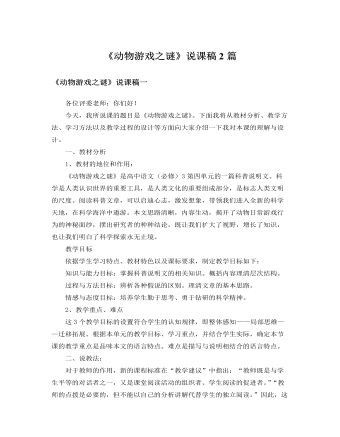
人教版高中语文必修3《动物游戏之谜》说课稿2篇
一、导入新课人类社会越来越现代化,新科学技术日新月异,令人目不暇接,称之到了“知识爆炸”的时代也毫不为过。由此而来的是生活的快节奏,学习和工作的竞争也越来越激烈。这种竞争一直波及到了儿童,加之中国几千年来形成的望子成龙的传统观念,使作父母的把一切希望都寄托在孩子身上,实现自己未能实现的理想。祖孙三代4、2、1的局面,使12只眼睛都盯在了孩子身上,真是走路怕摔着,吃饭怕噎着,干活怕累着,要星星不敢摘月亮,要吃什么跑遍全城也要买来。这种过分保护、溺爱及过早地灌输知识会得到什么结果呢?乐观者说孩子越来越聪明,越来越早熟,将来能更好适应现代化的要求;悲观者则认为豆芽菜式的孩子将来经不起风浪,小皇帝太多了很难凝聚成统一力量,将来谁去当兵,谁去干那些艰苦创业性工作……。对孩子本身来说,是幸福还是……在此不想多发议论,还是让我们来看看动物世界的孩子们吧,也许会得到某种启迪。
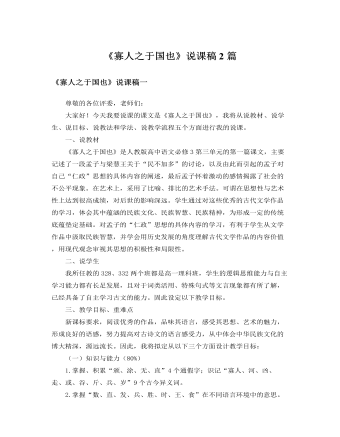
人教版高中语文必修3《寡人之于国也》说课稿2篇
(明确:“寡人之于国也,尽心焉耳矣”,但“寡人之民不加多,何也?”)②他认为自己对国家政务尽心尽力了,他有哪些具体做法?(明确:移民移粟)③第2—4节中孟子是怎样说明梁惠王移民移粟的措施与“邻国之政”并无本质区别的?(明确:孟子不直接回答“民不加多”的问题,而是用梁惠王熟悉的“战”设喻——设圈套,诱使对方在不知不觉中说出“不可,直不百步耳,是亦走也。”)④孟子认为怎样才能做到“王道之始”?要想“王道之成”还需采取哪些措施?(明确:“不违农时,谷不可胜食也。数罟不入氵夸池,鱼鳖不可胜食也。斧斤以时入山林,材木不可胜用也。谷与鱼鳖不可胜食,材木不可胜用五亩之宅,树之以桑,五十者可以衣帛矣。鸡豚狗彘之畜,无失其时,七十者可以食肉矣。百亩之田,勿夺其时,数口之家,可以无饥矣。谨库序之教,申之以孝涕之义,颁白者不负戴于道路矣。)这一小步的目的是想让学生通过这些问题的解答,可以进一步理清思路,掌握文的大概内容。
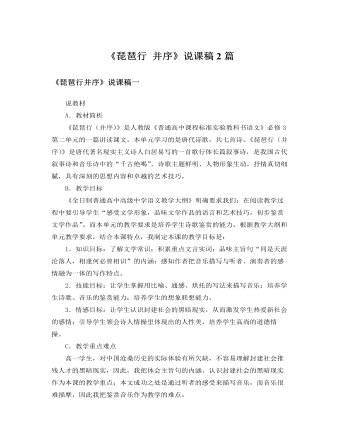
人教版高中语文必修3《琵琶行 并序》说课稿2篇
说教材A.教材简析《琵琶行(并序)》是人教版《普通高中课程标准实验教科书语文》必修3第二单元的一篇讲读课文。本单元学习的是唐代诗歌,共七首诗。《琵琶行(并序)》是唐代著名现实主义诗人白居易写的一首歌行体长篇叙事诗,是我国古代叙事诗和音乐诗中的“千古绝喝”。诗歌主题鲜明、人物形象生动,抒情真切细腻,具有深刻的思想内容和卓越的艺术技巧。B.教学目标《全日制普通高中高级中学语文教学大纲》明确要求我们:在阅读教学过程中要引导学生“感受文学形象,品味文学作品的语言和艺术技巧,初步鉴赏文学作品”。而本单元的教学要求是培养学生诗歌鉴赏的能力。根据教学大纲和单元教学要求,结合本课特点,我制定本课的教学目标是:1.知识目标:了解文学常识;积累重点文言实词;品味主旨句“同是天涯沦落人,相逢何必曾相识”的内涵;感知作者把音乐描写与听者、演奏者的感情融为一体的写作特点。
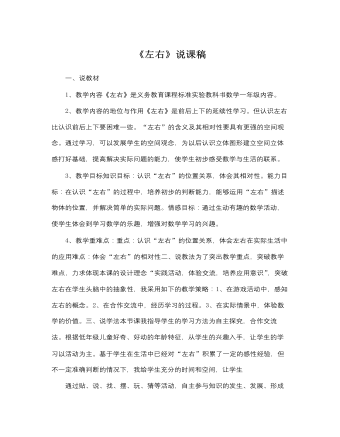
北师大版小学数学一年级上册《左右》说课稿
一、说教材1、教学内容《左右》是义务教育课程标准实验教科书数学一年级内容。2、教学内容的地位与作用《左右》是前后上下的延续性学习。但认识左右比认识前后上下要困难一些。“左右”的含义及其相对性要具有更强的空间观念。通过学习,可以发展学生的空间观念,为以后认识立体图形建立空间立体感打好基础,提高解决实际问题的能力,使学生初步感受数学与生活的联系。3、教学目标知识目标:认识“左右”的位置关系,体会其相对性。能力目标:在认识“左右”的过程中,培养初步的判断能力,能够运用“左右”描述物体的位置,并解决简单的实际问题。情感目标:通过生动有趣的数学活动,使学生体会到学习数学的乐趣,增强对数学学习的兴趣。
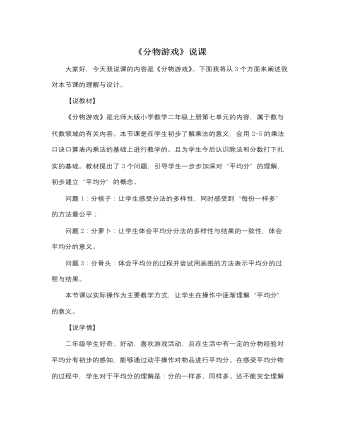
北师大版小学数学二年级上册《分物游戏》说课稿
大家好,今天我说课的内容是《分物游戏》。下面我将从3个方面来阐述我对本节课的理解与设计。【说教材】《分物游戏》是北师大版小学数学二年级上册第七单元的内容,属于数与代数领域的有关内容。本节课是在学生初步了解乘法的意义,会用2-5的乘法口诀口算表内乘法的基础上进行教学的。且为学生今后认识除法和分数打下扎实的基础。教材提出了3个问题,引导学生一步步加深对“平均分”的理解,初步建立“平均分”的概念。问题1:分桃子:让学生感受分法的多样性,同时感受到“每份一样多”的方法最公平;问题2:分萝卜:让学生体会平均分分法的多样性与结果的一致性,体会平均分的意义。问题3:分骨头:体会平均分的过程并尝试用画图的方法表示平均分的过程与结果。本节课以实际操作为主要教学方式,让学生在操作中逐渐理解“平均分”的意义。
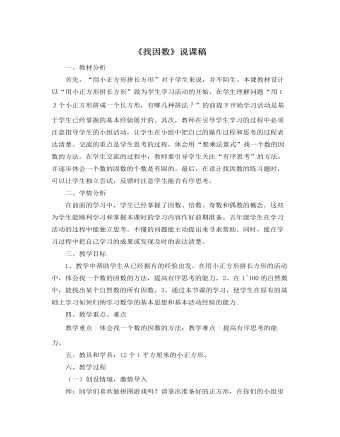
北师大版小学数学五年级上册《找因数》说课稿
【设计意图:让学生在操作、探索的基础上,组内交流想法,再在班内交流汇报,让学生的语言得到相互交流、碰撞,从而不断激发学生的思维火花。】师:你能把这些摆法用算式写出来吗?(学生独立写出算式并汇报)依学生汇报板书:1×12=122×6=1212×1=126×2=123×4=124×3=12师:请同学们观察一下,哪两道算式的因数一样?学生观察算式,找出因数一样的算式。师:那么,这6个算式最少能用几种算式表示出来?引导学生说出能用3种方法表示,这三种方法是:1×12=122×6=123×4=12,并指明算式一样时选择其中一种说出来。板书:12=1×12=2×6=3×4师:同学们观察一下,12的因数有哪几个?(学生说出12的因数有:1、12、2、6、3、4。)师:拼长方形与找因数有什么关系呢?(指名学生说一说)师:根据刚才的操作交流,请同学们说一说怎样找一个数的因数呢?(学生思考片刻后汇报,可以组内交流。)引导学生说出:用乘法思路想,看哪两个数相乘得12,然后一对一对找出来。
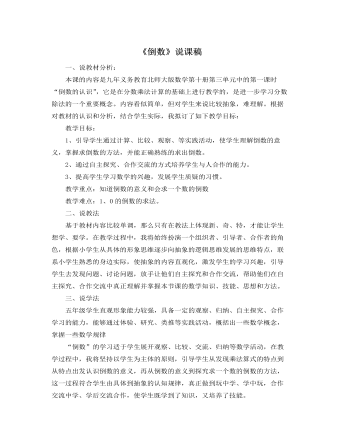
北师大版小学数学五年级下册《倒数》说课稿
教学目标:1、引导学生通过计算、比较、观察、等实践活动,使学生理解倒数的意义,掌握求倒数的方法,并能正确熟练的求出倒数。2、通过自主探究、合作交流的方式培养学生与人合作的能力。3、提高学生学习数学的兴趣,发展学生质疑的习惯。教学重点:知道倒数的意义和会求一个数的倒数教学难点:1、0的倒数的求法。二、说教法基于教材内容比较单调,那么只有在教法上体现新、奇、特,才能让学生想学、要学。在教学过程中,我将始终扮演一个组织者、引导者、合作者的角色,根据小学生从具体的形象思维逐步向抽象的逻辑思维发展的思维特点,联系小学生熟悉的身边实际,使抽象的内容直观化,激发学生的学习兴趣,引导学生去发现问题、讨论问题,放手让他们自主探究和合作交流,帮助他们在自主探究、合作交流中真正理解并掌握本节课的数学知识、技能、思想和方法。
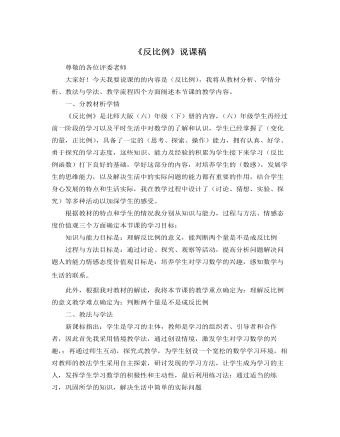
北师大版小学数学六年级下册《反比例》说课稿
知识与能力目标是:理解反比例的意义,能判断两个量是不是成反比例过程与方法目标是:通过讨论、探究、观察等活动,提高分析问题解决问题人的能力情感态度价值观目标是:培养学生对学习数学的兴趣,感知数学与生活的联系。此外,根据我对教材的解读,我将本节课的教学重点确定为:理解反比例的意义教学难点确定为:判断两个量是不是成反比例二、教法与学法新课标指出:学生是学习的主体,教师是学习的组织者、引导者和合作者,因此首先我采用情境教学法,通过创设情境,激发学生对学习数学的兴趣,;再通过师生互动,探究式教学,为学生创设一个宽松的数学学习环境,相对教师的教法学生采用自主探索,研讨发现的学习方法,让学生成为学习的主人,发挥学生学习数学的积极性和主动性,最后利用练习法:通过适当的练习,巩固所学的知识,解决生活中简单的实际问题
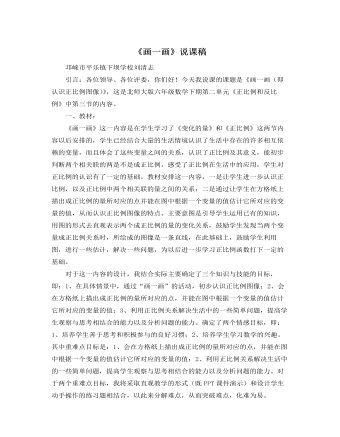
北师大版小学数学六年级下册《画一画》说课稿
一、教材:《画一画》这一内容是在学生学习了《变化的量》和《正比例》这两节内容以后安排的,学生已经结合大量的生活情境认识了生活中存在的许多相互依赖的变量,而且体会了这些变量之间的关系,认识了正比例及其意义,能初步判断两个相关联的两是不是成正比例,感受了正比例在生活中的应用,学生对正比例的认识有了一定的基础。教材安排这一内容,一是让学生进一步认识正比例,以及正比例中两个相关联的量之间的关系;二是通过让学生在方格纸上描出成正比例的量所对应的点并能在图中根据一个变量的值估计它所对应的变量的值,从而认识正比例图像的特点。主要意图是引导学生运用已有的知识,用图的形式去直观表示两个成正比例的量的变化关系,鼓励学生发现当两个变量成正比例关系时,所绘成的图像是一条直线,在此基础上,鼓励学生利用图,进行一些估计,解决一些问题,为以后进一步学习正比例函数打下一定的基础。
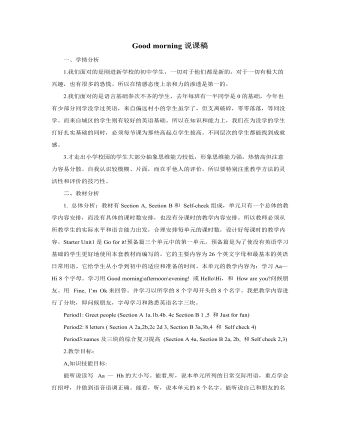
人教版新目标初中英语七年级上册Good morning说课稿
1.课堂活动中的竞赛制:以记奖评优的形式无声的评价每一个活动,包括个体和小群体。在第一课时评最佳演员和导演奖,第二课时评最佳团体奖,既节约时间又明确有效。使学生能提高语言质量,增强参与意识,提高学习兴趣。2. 教师课堂上语言、表情激励制:在课堂活动中教师要乐于 、善于用激励性语言。从good, super, smart, excellent , great ,wonderful等,用微笑,皱眉,摇头、点头等身体语言对于学生的评价是方便又有效的途径。3.课后作业评价:口头作业在第二天课堂上表演,接受全体同学的评价。笔头作业有教师批阅,以评语的方式出现。优秀作业予以展出或交流。积极地肯定和鼓励学生是我们评价的重要目的之一。4.单元结束后综合性评价:除了笔试以外,也可以根据学生实际开展丰富的活动,如:调查报告、小品表演、专题演讲等。

人教版高中英语必修1Journey Down the Mekong说课稿
2. let the Ss complete the forms paragraph by paragraph. Purpose here is to help Ss to get the habit of reading a passage as a whole, and pay attention to the organization of the text, as a result the Ss will fully understand the whole passage.3. ask Ss to retell the passage with the help of the key words in the form.Since the Ss in the class are in different levels, so I let them to fill in the blank to understand the meaning of the words and phrases better. ( That’s all for the while-reading. Now let’s move to the fifth step.)Step V: Post-reading (10mins) ---DiscussionIn this part students are asked to discuss in groups and list Wang Kun’s and Wang Wei’s attitudes about the trip. After that, Ss are encouraged to express their attitudes with the whole class. Collect their answers and don’t forget to praise them even if their answers may not be perfect.In this activity, discussion provides a vivid and active learning environment for Ss to communicate in English with newly learned language items. (Finally it comes to the homework.)StepⅥ: Homework (1min)1. Ss are required to read the text again after class and figure out the meaning of some complex sentences.2. Do the exercises on P19; This can help Ss to consolidate what they’ve learnt and make preparation for the next lessonPart4. Blackboard design.(说板书设计)On the top, there is the title of this lesson. On the left, there are main ideas for each paragraph. On the right, there are some new words and expressions.Unit 3 Travel journalJourney down the MekongMain idea of each para.:Para1: deciding to take a great bike trip along the Mekong river.Para2: Different attitudes between Wang kun and Wang wei.

人教版高中英语必修4Body Language说课稿4篇
Textbook: Senior English for China (Book 4), by Liu Daoyi Time Allotment: 1 period (40 minutes)Date: March 20, 2014Teaching aids: blackboard, Multi-media, Power Point, chalk I. Text Analysis (教材分析)This unit is about body language, and the text selected in the reading part demonstrates the difference and similarity of body language in many parts of the world. Through learning this passage, students are required to raise their awareness of using body language in different parts of the world. As body language is closely related to our daily life, it is easy to arouse students’ interest in learning this text. Reading skills and speaking training are designed around the text.II. Teaching Objectives (教学目标)By the end of the lesson, students will be able to:1. Language Skill Objective(语言技能目标): develop reading ability (skimming and scanning)as well as speaking ability.2. Cultural Knowledge Objective(文化知识目标): know about the cultural differences of using body language.3. Affective Objective(情感目标): increase students’ awareness of using body language correctly in different cultures. III.Teaching Focuses and Difficulties(教学重点和难点)1. Teaching Focuses(教学重点): the difference and similarity of body language in many parts of the world.2. Teaching Difficulties(教学难点): develop students’ reading abilities of skimming and scanning and ask the students to show their opinions with fluent English.

人教版高中英语必修1English around the world说课稿
(3)v. 给:提出;展现,显现present sb. with sth. ; present sth. to sb. 把. . 交给;颁发;授予present sth. (for sth. )/present sth. to sb. e. g. Om his birthday, his friends presented him a collection of stamps. 在他生日时,他的朋友们送给他一套邮票作为礼物。The sword was presented by the family to the museum. 这家人把宝剑捐赠给了博物馆。The committee will present the final report to Parliament in June. 委员会将在六月向议会提交最后的报告。You need to present yourself better. 你需要更善于展现自己。It is essential that we present a united front. 至关重要的是我们要表现得更加团结。Step 4 ConsolidationT:Now that we have got a general idea of these words and phrases. Lets make up some sentences using them to master them. Suggested sentences:1. Your duties include typing letters and answering the telephone. 2. It is one of the greatest roles that she has played. 3. A large number of people have applied for the job. 4. The number of the panda is declining. 5. I'11 go there, even if I have to walk. 6. He came up to me to ask for a light. 7. The novel is about a family who can't communicate with each other. 8. He based his plan on interests of most people. 9. Why doesn't he make use of his singing talent?Step 5 Summary and homeworkT:Today we dealt with several new words and phrases. After class I hope that youcan read them again and again to keep them in mind. That's all for today. You aredismissed.

人教版高中英语必修2Computers说课稿3篇
一. 教材分析1. 本单元的中心话题是“计算机(Computers)”,内容涉及计算机的发展历史,计算机的应用等。本节课是该单元的第一课时,我将Warming up, Pre-reading and Comprehending这四部分整合为一节精读课。其中。Reading部分是题为WHO AM I?的文章,以第一人称的拟人手法介绍了计算机发长演变的历史和计算机在各个领域的应用,其主旨是表达计算机的发展变化之快以及在生活中用途之广。而Warming up部分以图片的形式展现了计算机的发展历程;Pre-reading中的问题和排序分别是为了预测语篇的内容和测试学生对计算机历史了解的情况;Comprehending则通过各项练习训练学生的阅读技能,从而加深对文章的理解。可见这几部分是一个有机的整体。2. 教学目标:1) 语言目标:重点词汇及短语:abacus, calculate, calculator, PC, laptop, PDA, robot, analytical, technological, universal, mathematical, artificial, intelligent, network, explore, in common, as a result.重点句子:a. My real father was Alan Turing, who in 1963 wrote a book to describe how computers could be made to work, and build a “universal machine” to solve any mathematical problem.

人教版高中英语必修2Cultural Relics说课稿2篇
Ⅲ. Analysis of the teaching material:The topic of this unit is cultural relics. Students are quite interested in topics about different cultures around the world. This is the second period of the whole unit. As a reading class, the passage mainly talks about the history of the amber room (how it was made, sent as a gift, lost and rebuilt).According to the new national curriculum, when teaching reading, much emphasis should be put on training the students’ reading skills.Ⅳ. Teaching objectives1. Language objectives:1) Students are required to master the key words and phrases occurred in the passage (e.g. amazing, decorate, belong, in return, less than etc.)2) Students are required to learn the attributive clause and acquire the sentence pattern.2. 1) Students are required to describe a certain thing by using the new sentence patterns.2) Students are required to master two kinds of reading skills—skimming and scanning, and learn to use them in their daily reading.3. 1) Students are required to know the history of the amber room.2) Students are required to appreciate cultural relics and understand the importance of protecting them.Ⅴ. Teaching important and difficult points1) the new words, phrases, and sentence pattern in the course of reading.2) Teaching difficult point: Help the students master two kinds of reading skills—skimmingand scanning and learn to apply them in daily use.Ⅵ. Teaching methods:Task-based method & Top-down model Ⅶ. Teaching aids: PPT, pictures, blackboard Ⅷ. Teaching procedure:

人教版高中英语必修4A taste of English Humor说课稿3篇
Then I would ask them to think of a funny English or Chinese and tell it to partners. While telling stories, they can use expressions and some acting to help make the story funny. 5 minutes would be given to do this.Those stories they told there will be the material for their writing. Soletting them tell it at first is helpful. And they can make a difference between telling a funny story and writing it down. Generally speaking, it is difficult forstudents to write well because they don’t know what to write and how to write. Asking them to tell their own stories at first can help them come up with what to write.After their telling, I would invite someone to share his/her story with all of us and I would write it down on the blackboard.This example story would be used as a sample to illustrate the format of funny story. Different from a story from teacher or textbook, a story from students can obviously become a interesting material to draw students’ attention.Then I would ask the whole class to put this story into several parts. It might be a little bit difficult for them. So I would ask them to find out whether all the sentences are necessary. After delete some sentences, there are 6 sentences left behind. Then they can easily put them into three parts. After interaction with students, I would teach them the right terms for each part and conclude the format of funny story.This step is the key and difficult point in my lesson. So I mainly usetask-based teaching method in this part and the task for students was divided into several stages. With the separated difficult level, students can find there are usually three parts in writing. They can also learn to write without the unnecessary parts in the process of analyzing. And then I wouldn’t rush to tell them the right terms to them directly. Instead, I would ask them to name them by their own. A confused mind is better for acquiring knowledge.While-writing:Then I would give students 7 minutes to write down this story, without other requirements.With all the preparations in pre-writing, students’ difficulties were cleared. So it would be much easier for them to write down the story within 7 minutes. There are no other requirements because students’ first writing is actually a drafting. It would be revise and edit several times later. Writing, as a skill